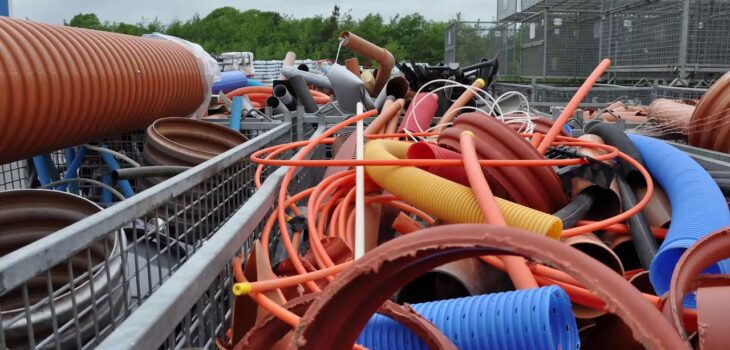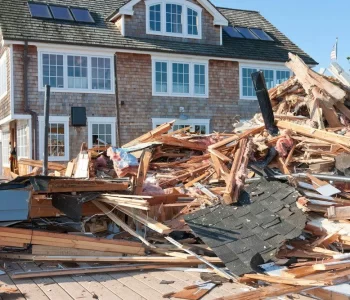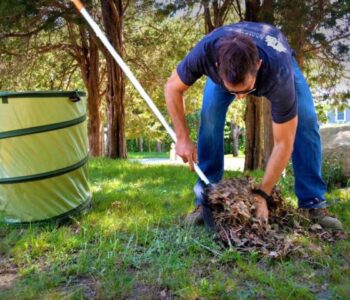 blog
blog
Is PVC Recyclable? How to Properly Dispose of PVC…
Polyvinyl chloride, commonly known as PVC, is one of the most widely used plastics globally. It is found in everything from plumbing pipes to flooring, medical devices, and even clothing. While PVC is a versatile and durable material, the question of whether it is recyclable has sparked considerable debate. As environmental concerns grow, it’s essential to understand the PVC recycling process, how to properly dispose of PVC pipes and tubes, and explore the various PVC recycling options available to ensure these materials don’t end up harming the environment.
This article will delve into the recyclability of PVC, provide insight into PVC waste management, and offer guidance on how to dispose of PVC responsibly.
What Is PVC and Why Is It Popular?
PVC is a synthetic plastic polymer made from vinyl chloride monomers. It is used in a wide array of products due to its strength, durability, and versatility. Some common uses of PVC include:
- PVC Pipes and Tubes: These are used in plumbing, drainage systems, and irrigation.
- Building Materials: PVC is used in window frames, flooring, and roofing materials.
- Medical Devices: Items like blood bags and tubing in hospitals are often made from PVC.
- Consumer Products: PVC is also found in packaging, credit cards, toys, and clothing.
PVC is an attractive material for many industries because it is lightweight, resistant to corrosion, and cost-effective. However, like many other plastics, the long-term environmental impact of its disposal has raised concerns. It is crucial to understand whether PVC can be recycled and how to dispose of it responsibly.
Is PVC Pipe Recyclable?
The short answer is yes, PVC pipes are recyclable. However, the process of recycling PVC is more complex than it might seem. The recyclability of PVC depends on its type, the additives it contains, and the recycling facilities available in your area.
There are two main types of PVC: rigid PVC (used in plumbing pipes) and flexible PVC (used in plumbing and electrical applications, as well as flooring). Both types can technically be recycled, but flexible PVC, due to its additives and plasticizers, can be more challenging to process.
PVC Pipe Recycling Process
Recycling PVC involves several stages. Here is a breakdown of the PVC recycling process:
- Collection and Sorting: The first step is to collect and sort the PVC waste. Not all PVC products are recyclable in the same way, so they must be separated from other types of plastic. For example, PVC pipes need to be sorted from other plastics to avoid contamination during the recycling process.
- Shredding: Once the PVC waste is collected, it is shredded into smaller pieces. This helps facilitate easier handling and processing.
- Cleaning: After shredding, the PVC is cleaned to remove any contaminants, such as dirt, oils, or adhesives. This is crucial because impurities can negatively affect the quality of the recycled PVC.
- Extrusion: The clean PVC is then melted down and processed through an extrusion machine, where it is formed into new products such as pipes, tiles, or decking materials. This stage helps transform the waste into a usable material again.
- Production of New Products: Finally, the recycled PVC is used to create new products, reducing the need for new raw materials. Some recycled PVC can be used for the production of new pipes, although it may sometimes be used for lower-quality products, such as flooring tiles, gutters, and other building materials.
Why Isn’t PVC Always Recycled?
While recycling PVC pipes is technically possible, there are several challenges to widespread recycling. The primary barriers include:
- Contamination: PVC often contains additives like stabilizers, plasticizers, and pigments that make it difficult to recycle. These chemicals can contaminate the recycling process and render the material less suitable for reuse.
- Cost: PVC recycling can be expensive. The cost of cleaning, sorting, and processing PVC is high, and this may discourage some recycling facilities from accepting PVC waste. As a result, many PVC pipes end up in landfills or incinerators rather than being recycled.
- Lack of Facilities: Not all recycling centers have the specialized equipment needed to process PVC. This limits the availability of PVC recycling centers and PVC recycling facilities, making it more difficult for consumers and businesses to recycle PVC materials.
- Low Demand for Recycled PVC: In some cases, there is limited demand for recycled PVC, especially when it comes to products that require high-quality, virgin PVC. This reduces the incentive to recycle PVC in large volumes.
How to Properly Dispose of PVC Pipes and Tubes
If recycling PVC is not an option in your area, it’s important to dispose of PVC pipes and tubes responsibly. Here are some effective PVC disposal methods:
1. Check with Local Recycling Centers
Before disposing of PVC waste, check with your local recycling centers to see if they accept PVC pipes and tubes. Some PVC recycling centers specialize in processing PVC, especially if it is free of contaminants. If recycling is an option, make sure to clean the pipes and remove any attached materials before dropping them off.
2. Contact a Professional Waste Management Service
For large-scale PVC disposal, consider hiring a professional waste management service that can handle PVC waste. These companies may have the equipment and resources needed to properly recycle or dispose of PVC. They may also be able to handle large quantities of PVC waste from construction sites or manufacturing facilities.
3. Repurpose PVC Pipes
If you are looking for an alternative to throwing out your PVC pipes, consider repurposing them. There are countless DIY projects that use PVC pipes, including:
- Garden Planters: Cut PVC pipes into sections and use them as planters for small plants and herbs.
- Furniture: PVC can be used to create inexpensive furniture, such as bookshelves or storage units.
- Home Decor: PVC pipes can also be used for making home decor items like curtain rods, wall art, or picture frames.
Repurposing PVC pipes is a creative way to give them a second life instead of sending them to the landfill.
Read: House Demolition Costs
4. Landfill Disposal
If recycling or repurposing is not feasible, PVC pipes may need to be disposed of in a landfill. However, this should be the last resort, as it contributes to environmental degradation. Always check with your local waste management guidelines to ensure proper landfill disposal.
PVC Waste Management
Proper PVC waste management is vital to reducing the environmental impact of PVC materials. Governments, businesses, and individuals all have a role to play in ensuring that PVC is disposed of in a way that minimizes harm to the planet.
- Reducing PVC Use: One of the most effective ways to manage PVC waste is by reducing its use in the first place. Opt for alternatives to PVC when possible, such as biodegradable or recyclable materials.
- Extended Producer Responsibility (EPR): Governments can implement EPR programs that hold manufacturers accountable for the disposal and recycling of their products. This can encourage companies to develop more sustainable PVC alternatives and take responsibility for their products at the end of their life cycle.
- Community Recycling Initiatives: Community-based initiatives can also help improve PVC recycling rates. By setting up PVC recycling programs and educating the public about the benefits of recycling, communities can make a significant impact on the reduction of PVC waste.
- Research and Innovation: Advancing research in the field of PVC recycling can help overcome the current challenges, such as contamination and the high cost of processing. Developing better techniques for recycling PVC materials could increase the efficiency and cost-effectiveness of PVC recycling.
PVC Recycling Options
If you are looking for PVC recycling options, here are some potential avenues to explore:
- Specialized PVC Recycling Centers: Many regions have facilities specifically designed for the recycling of PVC. These centers focus on PVC pipes, tubes, and other related products and can process large quantities of PVC waste.
- Plastic Recycling Programs: Many larger plastic recycling programs accept PVC as part of their standard collection, even if it requires specialized handling. Check with local waste management services to see if they offer this service.
- Manufacturer Take-Back Programs: Some manufacturers of PVC products offer take-back programs, where they will accept used PVC pipes or other products for recycling. Contact manufacturers or suppliers to inquire about such programs.
- Recycling Innovations: New technologies are continually being developed to improve PVC recycling. Stay informed about new PVC recycling methods and facilities in your area, as advancements in recycling processes may make it easier to recycle PVC in the future.
Conclusion
PVC is recyclable, but the process of recycling it can be complicated and expensive. PVC recycling offers a way to reduce the environmental impact of PVC, but challenges such as contamination, cost, and lack of specialized facilities still exist. Understanding how to properly dispose of PVC pipes and tubes is essential to ensuring responsible waste management.
Whether you are recycling PVC pipes or repurposing them for creative projects, taking action to reduce PVC waste will help contribute to a more sustainable future. By staying informed about PVC recycling centers, PVC waste management, and recycling PVC materials, you can make smarter choices that benefit both your community and the environment.





